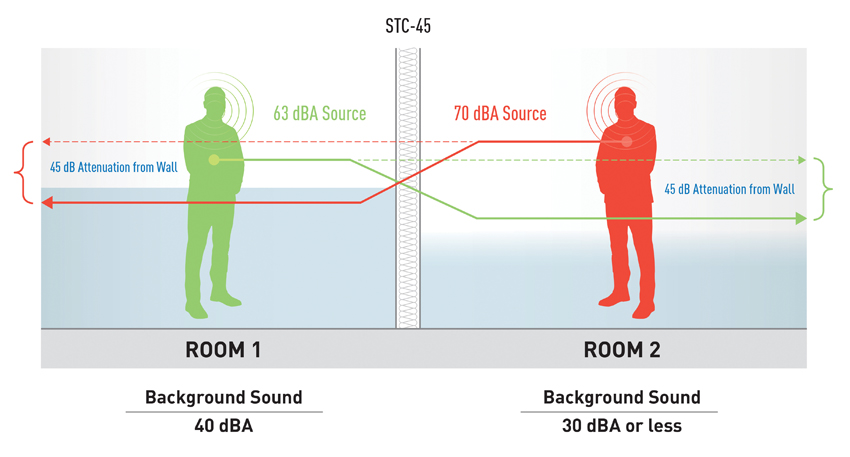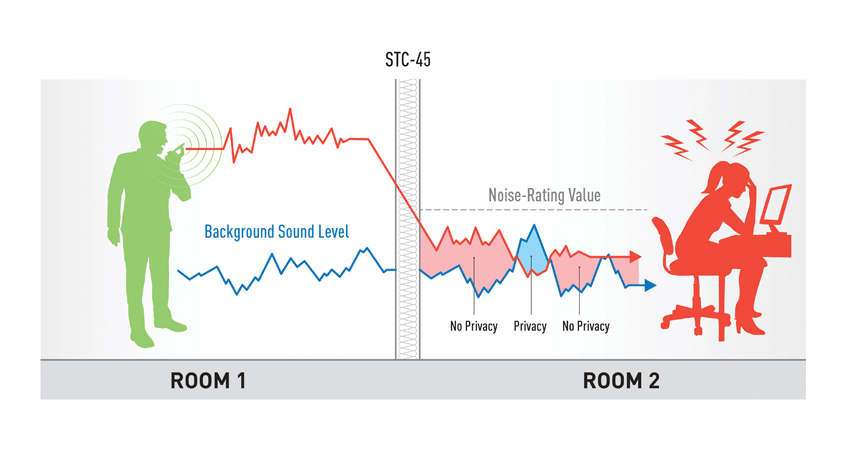In Pursuit of Acoustical Equity
Learning Objectives:
- Introduce the concept of acoustical equity.
- Discuss the role that acoustical privacy plays in achieving acoustical equity.
- Describe the need to control the temporal, spatial, and spectral qualities of background sound within the built environment.
- Explain the importance of tuning minimum background sound to meet a masking spectrum.
Credits:
This course is approved as a Structured Course
This course can be self-reported to the AANB, as per their CE Guidelines
Approved for structured learning
Approved for Core Learning
This course can be self-reported to the NLAA
Course may qualify for Learning Hours with NWTAA
Course eligible for OAA Learning Hours
This course is approved as a core course
This course can be self-reported for Learning Units to the Architectural Institute of British Columbia
Given the intense focus on health and safety as well as the changes in work/life balance precipitated by the COVID-19 outbreak, it is not surprising that the pandemic has accelerated the healthy-building movement and people-first mindset spearheaded by standards such as WELL Building Standard and Fitwel. There is burgeoning consensus that buildings need to be designed with deep commitment to the well-being of their occupants.

Photo: Vincent Lions Photography
Whether an organization wants its office to be occupied full-time post-pandemic or serve as a critical part of a hybrid working model, it has the potential to act as a great equalizer—a shared facility specifically designed to support employees’ work and well-being.
Effective acoustics are key to healthy buildings. After all, noise is known to provoke physiological stress responses that can negatively impact occupants. The World Health Organization describes it as an “underestimated threat” that contributes to stress, high blood pressure, cardiovascular disease, dementia, and diabetes. Hence, WELL and Fitwel take acoustics into consideration; however, it remains a poorly understood indoor environmental quality (IEQ) parameter—and the lowest rated.1
Returning to the Workplace
Low scores have added significance in today’s climate. Many employees found a silver lining in the ways in which stay-at-home orders enriched their family lives, even as the scope of their work and social lives contracted. As companies start to bring—or attempt to draw—them back to the office, occupant satisfaction is more important now than ever before. Organizations need to implement strategies that not only keep staff safe and healthy but also happy and productive enough within their working environment that they actually want to come into the office.
Amongst the architecture and design community, there is growing conviction that these goals must be achieved through concern with equity—and applied to real-world needs such as acoustical privacy, rather than amenities like pool tables, private chefs, and other perks. In other words, it is more a matter of how employees are treated than what they are being treated to.2
Firms such as Gensler point out that although employees are enjoying benefits (e.g., more time with family and less spent commuting) while working from home, many are also struggling with less-than-ideal conditions (e.g., poor internet connectivity, shared workspace with children and other family members, noisy neighbors and neighborhoods) that negatively impact their engagement and productivity. Whether an organization wants its office to be occupied full-time post-pandemic or serve as a critical part of a hybrid working model, it has the potential to act as a great equalizer—a shared facility that is specifically designed to support employees’ work and overall well-being.3
According to the Gensler’s U.S. Work From Home Survey 2020, 88 percent of employees would like to return to the workplace in some capacity. One of the primary reasons that the more than 2,300 participants cite is the need for a quiet, distraction-free environment—a desire echoed by the more than 32,000 people polled during studies that Steelcase conducted across 10 countries.4 It is clear that acoustics matter and hence are vital to ensuring that employees enjoy equal access not only to the facility itself but also the IEQ parameters needed to work comfortably and effectively.
But what exactly is acoustical equity, and how does one achieve it?
The Sound That Actually Exists
En route to answering these questions, one must first consider the traditional approach to acoustics, which relies on categorization and acceptable-level schemes prevalent throughout building standards and codes. The former specifies sound-rating values [e.g., sound transmission class (STC), noise isolation class (NIC), impact isolation class (IIC), ceiling attenuation class (CAC)] for the boundaries of a room or building envelope, while the latter uses noise-rating values [e.g., noise criteria (NC), noise rating (NR), room criteria (RC)] to set maximum limits for noise, such as that generated by building systems, services, and utilities. However, neither offer insight into the actual acoustics (i.e., the sound actually present) within a space or occupants’ experience of it.
To improve results—a goal that one can, with a broad brushstroke, call better acoustics—and fulfill the objective of designing with occupants in mind, one must turn his or her attention to the sound that is actually present within a space and look at it through the lens of both architectural acoustics (i.e., the study of sound and its behavior in and due to a space) and psychoacoustics (i.e., the study of the psychological and physiological effects of sound and its perception). Indeed, one cannot be separated from the other, as psychoacoustical evaluation of a space considers the outcome of the combined performance of all acoustical features.
Acoustical Privacy Is Key
The reactions of building occupants are captured using psychoacoustic metrics, some of which are subjective (e.g., surveys evaluating comfort, distraction, perceived productivity) and others that are objective (e.g., intelligibility, audibility).
Research shows that our overall acoustical satisfaction is strongly correlated with acoustical privacy, a concept with clear ties to the workplace but one that is also relevant to other environments; for example, surveys of multiunit residences demonstrate links between acoustical privacy and annoyance, fatigue, and sleeping problems (e.g., due to noise from traffic and neighbors).5 In other words, although people tend to equate acoustical privacy with speech privacy, the former is not limited to the intrusion of speech content—it also considers the audibility of unintelligible speech and other types of noise.
With that said, it is challenging to use acoustical privacy as a starting point for a conversation about acoustical equity. The science around acoustical privacy is not sufficiently nuanced, as it is not yet addressed by a standardized metric or even a proposed methodology.
Speech privacy, on the other hand, is both well-defined and measurable (e.g., using articulation index or speech privacy class). Therefore, it is a psychoacoustic metric that can be used in both theoretical (i.e., to illustrate the concept of acoustical equity) and practical ways (i.e., to set expectations during design and estimate occupants’ subjective impression of the built space). In this case, evaluation of acoustical privacy is effectively a review of the signal-to-noise ratio—it considers an intruding signal (speech) and its level relative to the background noise (or, rather, sound) in the receiving space.
By way of example, let us now turn our attention to the rooms—and occupants—shown in Figure 1:
- Room 1: The red arrows depict an elevated level of intruding noise compared to the green arrows. This case represents a well-designed space where the combination of the insulating properties of the wall (STC-45) and the constant background sound level of 40 A-weighted decibels (dBA) ensures that the noise is not intelligible and/or audible.
- Room 2: The green arrows depict a lower level of intruding noise. This case represents a space that fails to consider occupant needs and/or expectations. The combination of the insulating properties of the wall (still STC-45) and the existing background sound level (30 dBA or less) in the receiving room is insufficient to ensure acoustical privacy. Although the intruding level of the green source is lower than the red example, it remains intelligible and/or audible.
Now, let us assume that the red and green signals are people speaking. The red talker’s voice carries into Room 1; however, it is masked by the background sound. The listener in that room cannot identify and/or understand speech, and therefore the red talker enjoys speech privacy. The green talker’s voice is carried into Room 2; however, it is not masked by the background sound, and the listener can identify and/or understand speech. The green talker does not have speech privacy.
There are impacts beyond the one-way speech privacy. We accept that the red talker has speech privacy because the background sound in the adjoining room masks the received level of his or her voice. However, the red talker’s perception of privacy is violated because he or she is able to hear the green talker. This discrepancy can cause reactive behavioral changes by the red talker (e.g., lowering of voice, avoiding confidential topics). We also accept that the green talker does not have speech privacy because the background sound in the adjoining room does not mask the received level of his or her voice. However, the green talker has a false perception of privacy because he or she is unable to hear the red talker. This discrepancy can result in breaches of confidentiality, the implications of which can run the gamut—or gauntlet, depending on the consequences—from embarrassment all the way to legal proceedings.

Images courtesy of K.R. Moeller Associates Ltd.
Figure 1: The person (green) in Room 1 speaks at a Casual level, while the person (red) in Room 2 uses a Normal level (i.e., per Pearsons). Despite the latter’s elevated vocal effort, the person enjoys speech privacy due to the higher and consistent background sound level within Room 1. The person in Room 1, on the other hand, does not have speech privacy due to the lower and variable nature of the background sound in Room 2; however, the person believes he or she has privacy because he or she cannot hear the person in Room 2.

Figure 2: The person in Room 1 briefly has speech privacy—and the person in Room 2 a corresponding reprieve from disruption—when the background noise produced by the HVAC system temporarily reaches the level required for privacy, highlighting the need to establish minimum background sound levels in addition to maximum noise thresholds.
















